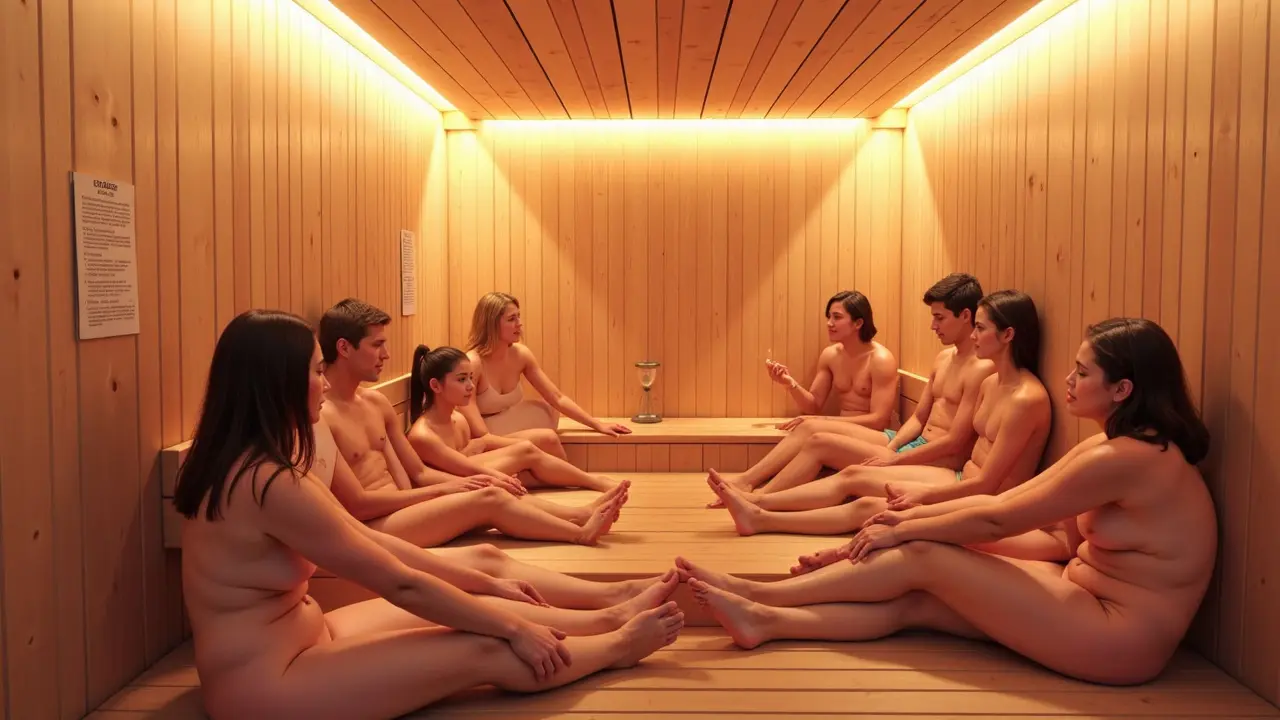You wouldn’t believe how many people wing it their first time in a sauna, sitting until they’re woozy or just bored. The sweet spot isn’t the same for everyone, but one thing’s certain: finding your ideal sauna session can transform the whole experience. Ever notice the Scandinavians, who have sauna rituals down to an art, don’t just sit and sweat endlessly? There’s real science, tradition, and even a touch of strategy behind every tunnel of steam. Let’s get real about how long you should actually stay in a sauna, what’s too little, what’s way too much, and how to get all those epic benefits without turning into a soggy raisin.
Sauna Session Length: The Essentials You Need to Know
Alright, you’re not here for vague ideas—you want some actual answers. So let’s break down the time you should clock in that hot wooden box. Most experts—and I’m talking about everyone from Finnish sauna societies to personal trainers obsessed with recovery—toss out 10 to 20 minutes as the magic number for a standard sauna session. Sounds simple, right? Well, there’s a bit more to it.
If you’re just starting out, shoot for 5 to 10 minutes. Dip your toes in (not literally; too hot!) and see how your body reacts. You’re not proving anything by toughing it out for longer. As you build up experience and get used to the heat, feel free to push that up to 15 or even 20 minutes. For the majority of people, around that 20-minute mark is plenty, even for seasoned sauna-goers. It’s enough time for your body to start reaping heart and metabolic perks without tipping into light-headedness or dehydration territory.
What about pros or die-hard fans who go longer? Some Finnish folks, especially during social sauna sessions, might split time: 2 or 3 rounds of 10 to 15 minutes, breaking for hydration and a cold plunge in between. The World Health Organization even ran studies describing how most adverse reactions happen beyond 20 minutes. Feeling sleepy, dizzy, or short of breath? Get out, hydrate, and chill. Sauna time isn’t an endurance contest.
Let’s talk actual numbers. New research from the University of Eastern Finland in 2022 (yes, real nerds in lab coats tested this) found that 15-minute sessions, repeated two or three times with a cool-down in between, delivered the biggest mood and cardiovascular benefits. Anything over a half hour per session offered zero extra perks—just more sweating and risk.
Below 5 minutes, you likely won’t experience much more than a quick warm-up—not the deep relaxation, cardiovascular benefits, or immune boost most people crave. Beyond 20 minutes without a break, you start gambling. Your heart is working overtime, your sweat rate goes through the roof, and dehydration creeps in fast—especially if you didn’t pound some water before stepping in.
Simple rule? Listen to your body. If you get lightheaded, dry-mouthed, or can’t catch a full breath, step out. Most seasoned enthusiasts agree: it’s smarter to split your session into two or three rounds of 10 to 15 minutes, sandwiching in a cool plunge, icy shower, or splash of water and chill time. This lets your system reset, and strangely, feels even better than one drawn-out sit.
Last thing: temperature matters. For a traditional sauna (Finnish style), 70°C to 100°C (160°F to 212°F) is normal. If you’re in a lower-temp infrared sauna, you might push 20 to 30 minutes—but that’s because infrared heats you differently (deeper, but gentler). Still, start slow, work your way up, and, again, trust your body’s signals.
If you need a quick cheat sheet, here’s a handy timing breakdown:
| Experience Level | Traditional Sauna (mins) | Infrared Sauna (mins) |
|---|---|---|
| Beginner | 5-10 | 10-15 |
| Intermediate | 10-15 | 15-20 |
| Advanced | 15-20 | 20-30 |
Treat these as guidelines, not rigid rules. If you leave wanting more, it’s better than rolling out feeling queasy.
Saunas: What They Are, Why They Matter, and What to Expect
Let’s strip away the mystique. A sauna is basically a small hot room—usually made of wood—designed to make you sweat buckets. Heat can come from wood stoves, electric heaters, or (with trendier, modern versions) infrared panels. There’s dry sauna, where humidity stays low, and steam sauna—sometimes called a Russian banya—where folks toss water on hot rocks for a steamy blast. Either way, the game is heat and sweat.
Why bother at all with sitting in a sauna? For starters, it’s not just about the sweat. In Finland, where the tradition is so wired into daily life that there are more saunas than cars, saunas are a social thing, a wellness ritual, and a major way to unplug. But you don’t have to live in Helsinki to get the perks.
Your body does some cool stuff in the sauna. Heart rate kicks up, blood vessels open, and you sweat like crazy. That means your skin gets a deep clean, muscles loosen up, and even mild aches or joint pain let up for a while. Research (like a 2020 paper in Mayo Clinic Proceedings) links regular sauna sessions to better heart health and lower risk of death from cardiovascular issues—by up to 50% in frequent users. Wild, right?
Beyond that, sauna time is a kind of forced mindfulness. You can’t scroll your phone much. You’re sitting, breathing, and letting yourself get lost in the heat. For folks fighting anxiety, burnout, or the aches from a long workweek, it’s a mini-reset. Your brain releases endorphins—those lovely, mood-boosting chemicals—just from the heat. You finish your session mellow, clear-headed, almost as if you meditated under a warm waterfall.
New twist: infrared saunas. These use special light to heat you up, going deeper with less surface heat. Some people swear by them for detox and skin improvements, though the evidence is still squishy compared to traditional saunas. Either way, the rhythm is the same: settle in, relax, and ride out the waves of heat and calm.
So what actually happens during a session? You come in, ditch your phone and shoes, usually strip down to a towel or swimsuit, and pick a bench (high is hotter, low is milder). As the sweat starts pouring, your heart pounds a little faster. The air feels intensely warm on your skin. If you’re in a traditional sauna, you might hear someone lob a scoop of water onto the rocks for a hiss of steam—instantly there’s a wave of heat, like a giant invisible blanket.
After 10 to 20 minutes (or less if you’re just starting), you’ll probably want to cool off. Some places have cold plunges, buckets of ice water, or just an open window for fresh air. You chill, hydrate, maybe chat. After a breather, lots of people head back in for round two. That repeat cycle is where much of the benefit comes from. It’s a sport, a social ritual, and a stress-buster rolled into one simple tradition.
Ever heard the saying, "In the sauna, everyone is equal"? It’s more than just a Finnish proverb—it’s the culture. CEOs, students, bakers, and athletes all sweating together, no hierarchy or stress. If you ask me, it’s one of the best social inventions ever.

Sauna Benefits, Risks, and Classic Mistakes to Avoid
Saunas aren’t just a spa day thing—they actually deliver some serious perks. For cardiovascular health, a long-term Finnish study (over 2,000 men, tracked for 20 years) found that people hitting the sauna four to seven times a week slashed their chance of dying from heart disease by more than half compared to folks who skipped out. More endorphins, improved blood flow, and even a lower risk of dementia and respiratory problems popped up in these studies, too.
Let’s talk muscle recovery. After a tough workout, the increased circulation and heat can help flush lactic acid and ease soreness. Olympic athletes have raved about this trick for ages. Plus, some physical therapists recommend regular sauna time for anyone with chronic joint pain or stiffness—heat loosens things up and helps your muscles (and mind) let go.
Your skin gets a free deep cleanse. Saunas open pores and kick sweat glands into overdrive, pushing out the daily grime and pollution. Many people with tough, acne-prone skin report a gradual improvement over weeks of regular sauna use. Just don’t expect instant miracles—your skin needs moisturizing after all that sweating or you’ll dry out fast.
Mental health? Huge. The tempo and warmth do wonders for stress. There’s a reason most people exit looking more relaxed than after a two-hour massage. It’s like your brain finally unplugs for a minute, letting worries melt away with every drop of sweat. Research confirms you get a nice uptick in serotonin and dopamine, which is why mood often spikes post-session.
What about risks? Saunas are safe for most healthy adults, but there are “don’t push your luck” rules. Never mix alcohol and saunas. Ever. Your body’s already losing fluids, and booze only speeds up dehydration. Certain health conditions—like pregnancy, unstable heart rhythm, or uncontrolled high blood pressure—mean you should check with your doctor first. And if you’re not hydrated, don’t risk it. Dehydration can sneak up quickly, leaving you lightheaded or, in rare cases, passing out.
A classic mistake: going all out the first time, sitting until you feel dizzy. Don’t be that person. It’s a marathon, not a sprint. Experienced users know when to step out. There’s zero shame in doing shorter rounds or taking a cold shower between sessions. In fact, that repeated cycle of heat and cool-down is what makes the tradition so powerful.
If you like numbers, here’s some more data: sweat loss in a standard 20-minute sauna session can average 0.5 to 1.0 liters. That’s why everyone—veterans and newbies alike—should chug water before and after. Good old H2O is your best friend here. Skip caffeine and alcohol before your session to avoid a double-whammy of dehydration.
Feel like spicing it up? Some people add essential oils to the water for a fragrant steam burst or pair their session with breathing exercises for extra relaxation. Just remember: more isn’t always better, especially with heat. Pick well-ventilated saunas, aim for those standard 10 to 20 minute rounds, and let your body call the shots.
Sauna Safety Tips, Prices, and How to Book Your Next Session
Let’s talk safety, because nobody wants their relaxation session to end in a face plant. First: drink water! Most sauna visits end with folks toting water bottles and chugging between rounds. You’re sweating buckets—up to a liter in 20 minutes—so bring water, and sip before, during cool-downs, and after. If you add a cold plunge or shower, make sure you’re not jumping suddenly if you’re feeling faint. Ease into it.
Clothing-wise: wear as little as your local rules allow. In traditional Finnish saunas, towels are the norm. Some spas or gyms require swimsuits for modesty, but anything snug traps more heat—loose and minimal is key. Bring an extra towel to sit on (for both comfort and hygiene) and grab a third if you want to dry off between rounds.
Shower before you go in. It helps keep the sauna clean, opens your pores a bit, and feels great. No lotions, creams, or heavy perfumes—you’ll sweat it off anyway, and it can stain benches or stink the place up. If you’re heading to a public sauna, check for quiet hours or busy times if you prefer space.
Watch your step—benches can get slick, and the heat can sometimes make you woozy as you stand. Move slow, and always sit up for a few seconds before standing fully to avoid head spinning. If you feel dizzy, nauseous, or short of breath, leave right away and cool off. No shame in an early exit—everyone’s tolerance is different.
About pricing: it’s all over the board. In major cities, drop-in sauna sessions at gyms or day-spas usually start at $15–$30 per hour. Fancier wellness clubs, especially in wellness hotspots like LA or NYC, might run $50 and up—sometimes more if bundled with massages or recovery pools. If you join a gym with a sauna, monthly memberships can make it far more affordable for regular use. Planning a traditional bathhouse trip? Expect a flat fee for all-day access (often $30–$60), with extras like towel or robe rental tacked on.
How to book? Most modern gyms, wellness centers, and spas let you reserve online. Many even have apps. If you’re going with friends, book multiple spots in advance—they fill up fast, especially in winter. Pro tip: some places offer off-peak discounts on weekdays or early mornings. Bring your own water bottle, a couple of towels, and basic flip-flops.
So, ready to try it? There’s no right or wrong—just play it safe, listen to your body, and enjoy the calm that comes after a solid sweat session. Book your session, hydrate up, and see what all the fuss is about.







August 7, 2025 AT 16:51
I've been using saunas for years, and honestly, the session length really depends on your experience and how your body reacts. Some people can comfortably stay 20-30 minutes, but beginners really need to start slow, like 5 to 10 minutes. It’s tempting to push yourself, but overheating is no joke.
Also, it’s crucial to stay hydrated before and after your sauna time. I always keep a water bottle nearby, and honestly, the breaks between sessions where you cool down make a huge difference.
Furthermore, I noticed that the benefits like muscle relaxation and improved circulation kick in more effectively when you cycle between short sauna bursts and cool downs. So, instead of one long session, multiple short stays work better for me.
For first-timers, maybe start with a 5-minute run, then a 5-minute break, and repeat once. Over time, you can build up safely. The key thing is listening to your body and making sure you feel good throughout. Never push through dizziness or nausea.
What do others think about session lengths? Do you favor fewer longer sessions or several shorter ones?